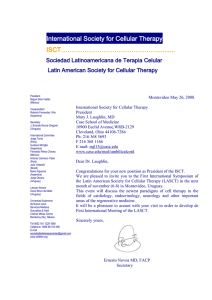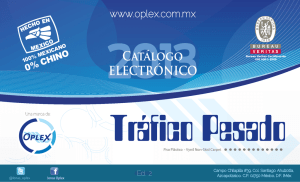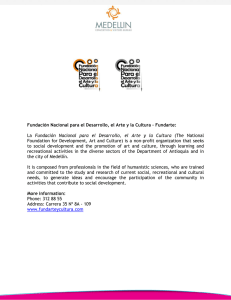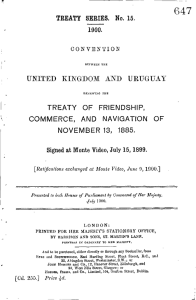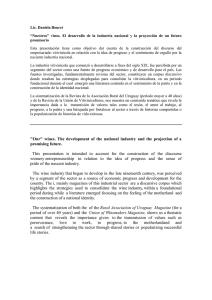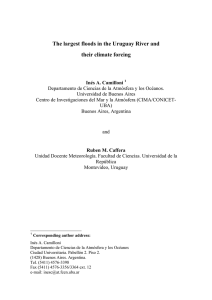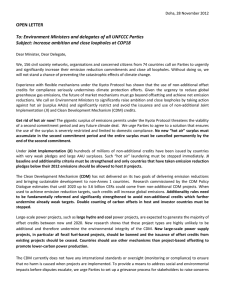Eloísa Ibarra (Montevideo - Uruguay, 1968) "The Seed of Babel
Anuncio
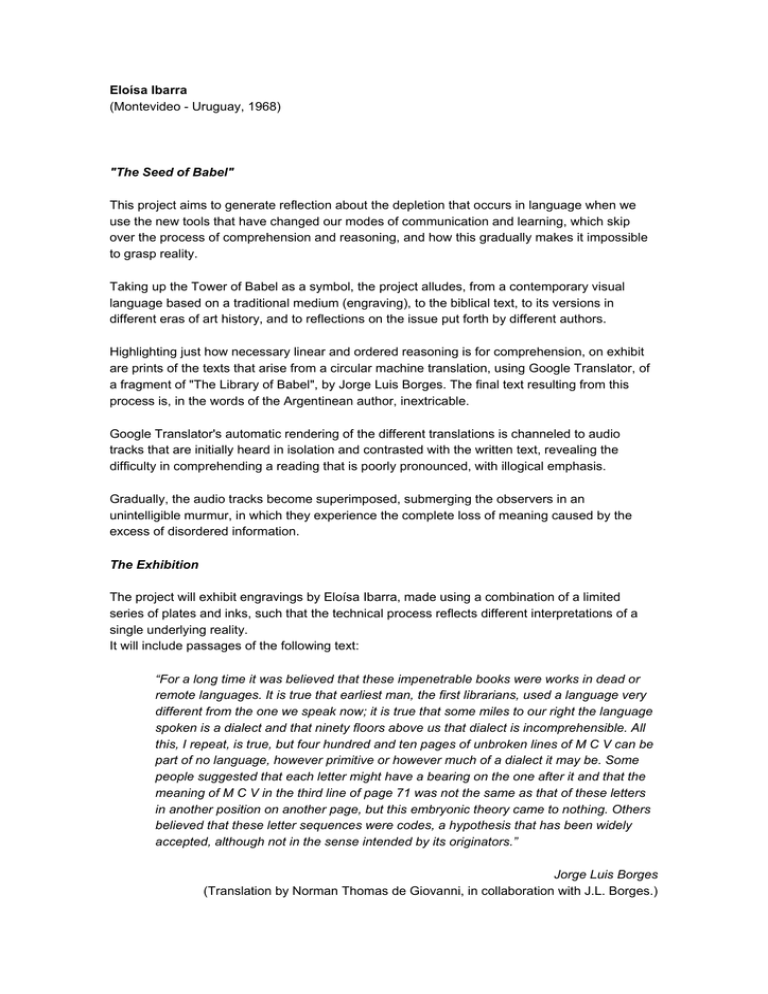
Eloísa Ibarra (Montevideo - Uruguay, 1968) "The Seed of Babel" This project aims to generate reflection about the depletion that occurs in language when we use the new tools that have changed our modes of communication and learning, which skip over the process of comprehension and reasoning, and how this gradually makes it impossible to grasp reality. Taking up the Tower of Babel as a symbol, the project alludes, from a contemporary visual language based on a traditional medium (engraving), to the biblical text, to its versions in different eras of art history, and to reflections on the issue put forth by different authors. Highlighting just how necessary linear and ordered reasoning is for comprehension, on exhibit are prints of the texts that arise from a circular machine translation, using Google Translator, of a fragment of "The Library of Babel", by Jorge Luis Borges. The final text resulting from this process is, in the words of the Argentinean author, inextricable. Google Translator's automatic rendering of the different translations is channeled to audio tracks that are initially heard in isolation and contrasted with the written text, revealing the difficulty in comprehending a reading that is poorly pronounced, with illogical emphasis. Gradually, the audio tracks become superimposed, submerging the observers in an unintelligible murmur, in which they experience the complete loss of meaning caused by the excess of disordered information. The Exhibition The project will exhibit engravings by Eloísa Ibarra, made using a combination of a limited series of plates and inks, such that the technical process reflects different interpretations of a single underlying reality. It will include passages of the following text: “For a long time it was believed that these impenetrable books were works in dead or remote languages. It is true that earliest man, the first librarians, used a language very different from the one we speak now; it is true that some miles to our right the language spoken is a dialect and that ninety floors above us that dialect is incomprehensible. All this, I repeat, is true, but four hundred and ten pages of unbroken lines of M C V can be part of no language, however primitive or however much of a dialect it may be. Some people suggested that each letter might have a bearing on the one after it and that the meaning of M C V in the third line of page 71 was not the same as that of these letters in another position on another page, but this embryonic theory came to nothing. Others believed that these letter sequences were codes, a hypothesis that has been widely accepted, although not in the sense intended by its originators.” Jorge Luis Borges (Translation by Norman Thomas de Giovanni, in collaboration with J.L. Borges.) This fragment from "The Library of Babel" was then translated using Google Translator from English to Spanish, to French, to Italian, to Arabic, to German, to Chinese, to Portuguese, and then back to English, producing the following result: “This is a very long period of time, these books can not be compromised, he was found dead in the language or work remotely believe. Of course, the man first, librarians, and for the first time in a few very different languages we speak today, it is true, a few kilometers for our rights, and language is a dialect, and 90 above the ground, as the tone is understandable. Again, all of which this is true, but 410 of a full line ofcardiovascular and cerebrovascular diseases, can be a part of any language but one.Original or clay has been suggested that each character can have a future and a sense of MCV in the third line 71 is not a different location in another message on the page,but not according to this theory is not embryonic. Some people think that the code sequence of characters is widely accepted assumptions, instead of registering the meaning of the author's intention.” The versions of the different languages and the final text will be presented on the walls of the gallery space. In addition, there are audio recordings of the machine reading that Google Translator makes in each of the languages. These tracks will be reproduced through QR codes read by image readers in cell phones or wireless headphones available for the visitors. In the end is an endless track in which all of the translations gradually accumulate. Listen to the sample: The QR code leads to: http://www.eloisaibarra.com/babel.mp3 Specifications Curator / text: Alfredo Torres (Uruguay) Text: Graciela Kartofel (Mexico DF - New York) Translator: Linda Dorow (Minneapolis) - Up to 20 engravings made using three or four superimposed techniques (intaglio on MDF, etching on zinc plate, engraving on photopolymer and/or Hayter prints), of different sizes. - Audio recordings accessed using QR codes in different parts of the gallery, with an option for visitors to request wireless headphones for this purpose. - Texts cut from vinyl, posted on the walls. Brochure The project includes a book/brochure designed by the artist, with texts, reproductions of the exhibited artworks and of others by the artist related to this theme, as well as technical specifications and biographical profile, in English and Spanish, which will be distributed free of charge to visitors to the exhibition. Dimension: 220*180mm Softcover, coated paper 300 g CMYK + matte lamination 48 pages, matt coated paper 170 g CMYK perfect binding 1500 copies ISBN Printed in Uruguay Schedule July 18 - August 6, 2013 Exhibition: Carmelo de Arzadun Gallery, Gallino Museum Salto City, Uruguay Lecture by Alfredo Torres (curator) and the artist: APLAS (Saltenian Plastic Art Association) headquarters, Salto November 3 - 16, 2013 Exhibition: Quarter Gallery, Regis Center for Art University of Minnesota, Minneapolis, United States Printmaking workshop by Eloísa Ibarra: Department of Art, University of Minnesota Funding The project has been awarded with the Funds for Culture program of Uruguay's Ministry of Education and Culture (http://fondoconcursable.mec.gub.uy) in an open competition. The fund covers the entire project, the transportation costs of the artist and her works, the printing of the catalogue and other production and exhibit expenses. Eloísa Ibarra Visual Artist Address: Av. Libertador 1513, Apt. 902 CP 11100 Montevideo, URUGUAY Tel. (+598) 2901 5732 Cel. (+598) 094 245 266 e-mail: [email protected] web site: www.eloisaibarra.com Résumé Education Universidad del Trabajo del Uruguay, Escuela Dr Pedro Figari, UTU. Diseño Gráfico (graduada en 1988) Escuela Nacional de Bellas Artes. 1er y 2do año (1989-90) Foto Club Uruguayo. Fotografía blanco y negro y color (1992-94) Centro de Expresión Artística CEA. Taller Nelson Ramos (2000-2002, 2004-2005) Taller Clever Lara. Taller de collage con Gustavo Fernández (2003) Taller Pedro Peralta. Grabado en madera y metal (2005-09) Taller Cebollatí. Grabado en metal con Claudia Anselmi (2010-12) Since 1990 the artist has participated in many courses, technical and theoretical workshops, as well as clinics and seminars. Some highlights of recent years: Introducción al Grabado Electrolítico con Alfonso Crujera (España) en Centro de las Artes San Agustín, Oaxaca, México (2009) Taller de técnica Hayter I y II con Rimer Cardillo en Taller Cebollatí (2010-11) Taller de grabado en fotopolímero con Rimer Cardillo en Taller Cebollatí (2012) Branding for museums Seminario dictado por Lyndel King and Shelly Reagan, Museo Nacional de Artes Visuales, Montevideo. Design and Cultural Promotion From 1990 to 2004, the artist worked in graphic design in advertising, and since 2005 has worked independently, specializing in the editorial design of art publications and catalogs. Since 2007, she has been active in cultural promotion projects, coordination of exhibitions and research in art topics: - Coordinación y diseño exposición “Mixturas” con curaduría de Pablo Thiago Rocca. Artistas: Águeda Di Cancro, Anhelo Hernández, Cecilia Mattos, Rafael Lorente (Uruguay), Pablo Ortiz Monasterio (México) y Gerardo Suter (Argentina), Centro Cultural de México, Embajada de México en Uruguay. Montevideo (2007) - Asistente curatorial Premio Figari, Banco Central del Uruguay, edición 2006. Coordinación exposición y edición libro-catálogo de la artista Leonilda González, BCU Sala Figari, Montevideo, Uruguay (agosto de 2007) (www.bcu.gub.uy/autoriza/sgoioi/dossier_lgonzalez.pdf) - Premio Ideas y Contenidos Digitales “Diccionario de Arte Uruguayo”, co-autoría con Pablo Thiago Rocca. Ministerio de Educación y Cultura del Uruguay (2007) - Co-investigadora junto a Pablo Thiago Rocca y diseñadora del proyecto “Arte Otro en Uruguay” premiado por los Fondos Concursables MEC 2008 y seleccionado por el Programa Plataforma Centro MEC (www.arteotroenuruguay.blogspot.com) - Coordinación y diseño exposición “Arte Otro en Uruguay”, Plataforma Centro MEC. Montevideo, Uruguay (2008) (www.plataforma.gub.uy/actividades/arte%20otro.htm) - Auxiliar docente de Pedro Peralta “Oliendo la huella en la era del posgrabado”. Museo Nacional de Artes Visuales, MNAV. Montevideo, Uruguay (2008) - Responsable del proyecto “Taller itinerante de grabado y exposiciones” Talleres de xilografía en localidades del interior del país. Docencia a cargo de Pedro Peralta, Eloísa Ibarra y Gerardo López. Con el apoyo del Museo Nacional del Grabado y las Direcciones Departamentales de Cultura de Maldonado, Salto, Soriano y Rivera (proyecto premiado por los Fondos Concursables para la Cultura 2009, Dirección Nacional de Cultura MEC) - Responsable y docente de curso-taller “Grabado calcográfico en mdf”. Taller Rufino Tamayo, Oaxaca de Juárez, México (noviembre de 2009) - Diseño y edición del sitio web del Museo de Arte Precolombino e Indígena MAPI (Intendencia Municipal de Montevideo) (2009-2010) - Ponencia en Seminario “Disciplina/Indisciplina, encuentros y desencuentros acerca de lo visual en el espacio urbano”, “Arquitecturas otras” junto a Pablo Thiago Rocca, marzo de 2010. Centro Cultural de España, Montevideo. - De 2010 a marzo de 2012 a cargo de diseño e imagen institucional del Museo Figari (MEC, DNC) Visual Arts Since 2001, the artist has exhibited her work regularly in solo and group shows and has participated in numerous prizes, biennials and salons in Uruguay and abroad, with engravings, paintings, sculptures and installations. Among these: I Bienal Internacional de Grabado Paco Urondo, UBA Facultad de Filosofía y Letras. Buenos Aires, Argentina. (2011) “IX Bienal de Salto”. Salto, Uruguay (2011) Arte Visual Iberoamericano, exposición itinerante (Fondo Nacional para las Artes de México / Agencia Española de Cooperación Internacional para el Desarrollo) 10 artistas por 10 países de Latinoamérica (2010-12) “Ancestros” Centro Cultural Alianza Francesa de Montevideo. Bastión del Carmen, Colonia del Sacramento. Casa de la Cultura de Maldonado (2010-11) Arte “NO-ON” 27 artistas activados contra la violencia hacia mujeres y niñas. Fundación VisionAir (2010) “2da. Muestra de Arte Iberoamericano” Centro Nacional de las Artes, México DF (2009) “VI Bienal Internacional de Arte Siart” Espacio Simón I. Patiño, La Paz, Bolivia (2009) “53º Premio Nacional de Artes Visuales Hugo Nantes” MNAV, Museo Nacional de Artes Visuales. Montevideo, Uruguay (2008) “V Bienal Internacional de Arte Siart” Museo Nacional de Arte La Paz, Bolivia (2007) 1er. Encuentro Nacional de Escultores. Exposición y emplazamiento de escultura en Parque Público. Palmar, Soriano. Uruguay (2006) “Trienal Iberoamericana de Grabado” Museo Sívori, Buenos Aires, Argentina (2006) SOLO EXHIBITIONS - “Grabado en la memoria”, Artebar Café Tribunales, Montevideo (2013) - “Obra gráfica 2005 - 2012”, Centro Cultural de La Paloma. La Paloma, Rocha (2013) - La Commedia Espacio de Arte. Montevideo, Uruguay (2011) - “Un día más” EAC Espacio de Arte Contemporáneo. Montevideo, Uruguay (2010) - “Pinturas recientes,” Galería Grillo Arte. Punta del Este, Uruguay (2010) - “Horizontes” Galería del Goethe-Institut Montevideo, Uruguay (2008) - “Sueños” Sala de Arte Meridiano, Montevideo, Uruguay (2007) - “Grabados” Galería 525. Montevideo, Uruguay (2006) - Centro Cultural de La Paloma. La Paloma, Rocha (2005) AWARDS AND RECOGNITIONS Premio Adquisición Asociación Médica de San José, Salón Nacional de Pintura de San José (2012) Mención Especial del Jurado, I Bienal Internacional de Grabado Paco Urondo, Museo Nómade de Grabado. UBA Facultad de Filosofía y Letras. Buenos Aires, Argentina. (2011) Premio Adquisición Intendencia de Durazno, 3er. Concurso de Pintura ISUSA (2011) Proyecto seleccionado 2da Edición Concurso de Esculturas World Trade Center Montevideo, Uruguay (2010) Escultura realizada en Plaza de las Torres WTC (2011) Beca Fonca-Conaculta, Residencia Artística en Centro de las Artes San Agustín, Oaxaca, México (2009) 1er. Premio Gran Premio Nacional “IV Salón del Grabado Uruguayo 2008”. Museo Nacional del Grabado, Fundación Lolita Rubial. Minas, Uruguay (2009) Mención Especial “III Salón del Grabado Uruguayo 2006”. Museo Nacional del Grabado, Fundación Lolita Rubial. Minas, Uruguay (2007) Primer Premio Escultura. Premio Fundación Zitarrosa. Montevideo (2006) Mención de Honor Nacional. Salón Internacional "Intergrabado 2005" Museo Nacional del Grabado, Fundación Lolita Rubial (2006) Mención Especial, Categoría Pintura. Salón del Vino, INAVI (2005) Mención de Honor, Categoría Pintura. 2da. Bienal de Arte Joven Mosca Hnos. (2001) www.eloisaibarra.com
